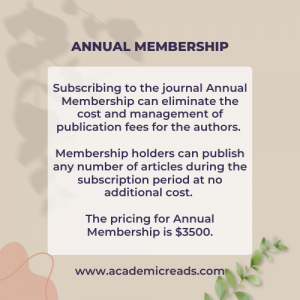Author Guidelines
1. Title/Heading: Suitable to the subject and not irrelevant to its detailed work.
2. Author Affiliation: Respective Author Full Name, Department/Institution/University, City should be drafted with the article.
3. Corresponding Author:Full Name, Department/Institution/University, City, State, Country, Telephone, Fax, and Email.
4. Abstract: Should be relevant, self-explanatory, comprehensive, and brief in nature correlating to the total subject matter and give a notion as a summary to the detailed script portrayed by the author while getting the experimental findings in an exhaustive manner. It should also relate to the significant outcomes and further scope to continue in the field.
5. Keywords: In alphabetical order, separated with semicolons and exhibit catchy nature with respect to the subject.
6. Text includes the following:
- Introduction: states the reason for the research: identifies and discusses findings of others, includes a review of the literature.
- Materials and Methods: describes the research population or study sample, describes the method used to gather information or data collection, and describes the means used for measuring or measures.
- Results: summarizes the results and presents findings using text, charts, graphs and tables, Legends for tables, charts, graphs, and figures.
- Discussion: analyzes findings, explains the significance of the research, and suggests future projects
- References: Vancouver Reference Style
7. Acknowledgement: Includes affirmation of individuals, grant details, funds, and conflict of interest.
8. Preferred Format: Microsoft Word


Submission Preparation Checklist
As part of the submission process, authors are required to check off their submission’s compliance with all of the following items, and submissions may be returned to authors that do not adhere to these guidelines.
- The submission has not been previously published, nor is it before another journal for consideration (or an explanation has been provided in Comments to the Editor).
- The submission file is in OpenOffice, Microsoft Word, or RTF document file format.
- Where available, URLs for the references have been provided.
- The text is single-spaced; uses a 12-point font; employs italics, rather than underlining (except with URL addresses); and all illustrations, figures, and tables are placed within the text at the appropriate points, rather than at the end.
- The text adheres to the stylistic and bibliographic requirements outlined in the Author Guidelines.
Peer Review Process
- An editor is assigned for every manuscript received. An initial screening is done and a decision is reached about formal peer-review of the manuscript based on its quality and suitability for publication in this journal.
- For peer-review of the manuscript, two reviewers are asked to review the paper.
- The editor(s) reach a decision on accepting or rejecting the paper by taking into consideration the reviewers comments, quality of the manuscript, and editorial priority of the journal.
- The decision is communicated to the author(s).
- The average duration of the peer review process is approximately 21 to 28 days.
Article Processing Charges
In order to provide free access to readers, and to cover the costs of peer review, copyediting, typesetting, long-term archiving, and journal management, an article processing charge (APC) of 1000 USD applies to papers accepted after peer review.
Many national and private research funding organizations and universities explicitly cover APCs for articles resulting from funded research projects. Discounts are available upon an evaluation on a case-to-case basis.
Indexing



- Home
- Books
- ARJMDR
- Information for Authors
Get In Touch
- Plot No 160, NGOs Colony, Vanastalipuram, Hyderabad, India
- contact@academicreads.com